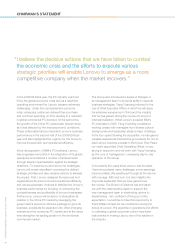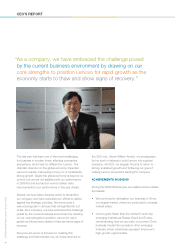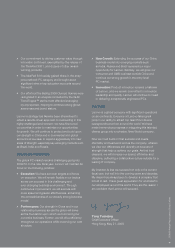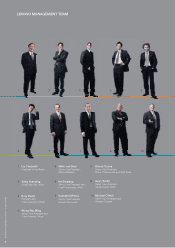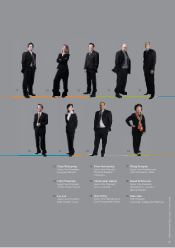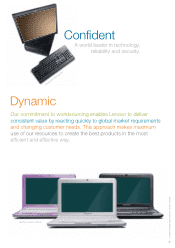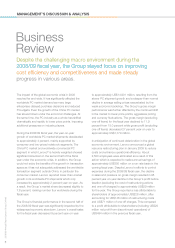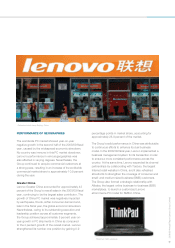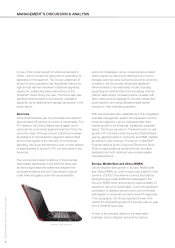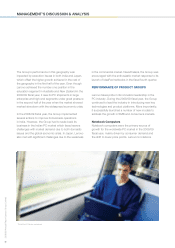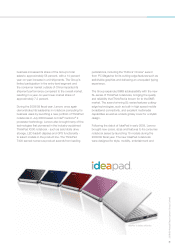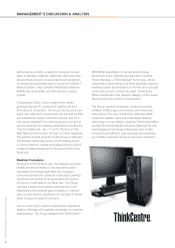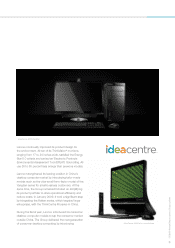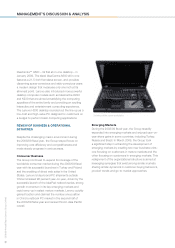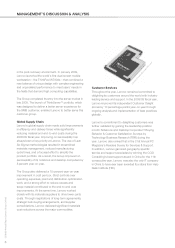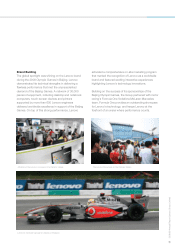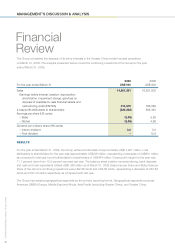Lenovo 2009 Annual Report Download - page 18
Download and view the complete annual report
Please find page 18 of the 2009 Lenovo annual report below. You can navigate through the pages in the report by either clicking on the pages listed below, or by using the keyword search tool below to find specific information within the annual report.
MANAGEMENT’S DISCUSSION & ANALYSIS
2008/09 Annual Report Lenovo Group Limited
16
In view of the robust growth of notebook demand in
China, Lenovo focused its resources on expanding its
leadership in this segment. The Group’s alignment of
its end-to-end business model, specifically tailored for
high-end as well as mainstream notebook segments,
resulted in outstanding sales performance of the
ThinkPad® brand during the year. The Group also saw
significant improvement in its customer acquisition
capability via its relationship business, particularly in the
public sector.
Americas
In the 2008/09 fiscal year, the Americas accounted for
approximately 25 percent of Lenovo’s overall sales. The
PC market in the United States was sluggish and in
particular the commercial segment was hard hit by the
economic crisis. Although Lenovo’s efforts to increase
its presence in the transaction segment helped offset
some of the impact of the reduction in commercial
spending, the Group still reported a year-on-year decline
of approximately 6 percent in PC unit shipments in the
Americas.
The commercial market conditions in the Americas
deteriorated significantly in the 2008/09 fiscal year
as many large enterprise customers delayed their
purchase decisions and cut IT spending to reduce
costs while struggling under the unprecedented
IdeaPad Y430 notebook
economic challenges. Lenovo implemented a market
crisis program by tailoring its offerings even more to
increase customer value during the economic downturn.
In addition, the Group also introduced significant
enhancements to its relationship model, including
expanding its market footprint by increasing channel
partner relationships, increasing share-of-wallet with
tailor-made product catalogs for the mid-market and
public sectors, and using dedicated sales teams
focused on new business acquisition.
With improved execution, establishment of an integrated
business management system and expansion into the
consumer segment, Lenovo delivered better-than-
market growth in the Americas’ transaction business
space. The Group reported a 14 percent year-on-year
growth in PC unit shipments during the 2008/09 fiscal
year by gaining traction in consumer and SMB markets,
as well as in Latin America. The launch of IdeaPadTM
S-series netbook at the Consumer Electronics Show
2009 brought additional excitement with favorable
feedback from both retail and value added reseller
business partners.
Europe, Middle East and Africa (EMEA)
Lenovo enjoyed solid growth in Europe, Middle East
and Africa (EMEA) up until the economic crisis hit in the
summer of 2008. The extreme currency fluctuations
during the year posed additional challenges to the
Group in EMEA which accounted for approximately 21
percent of Lenovo’s overall sales. Due to the significant
contraction of desktop demand and Lenovo’s limited
participation in consumer and entry-level PC segments
in the geography, the Group reported a lower-than-
market PC shipments growth of 6 percent year-on-year
for the 2008/09 fiscal year.
In view of the demand decline in its relationship
business, Lenovo aligned resources to capture


